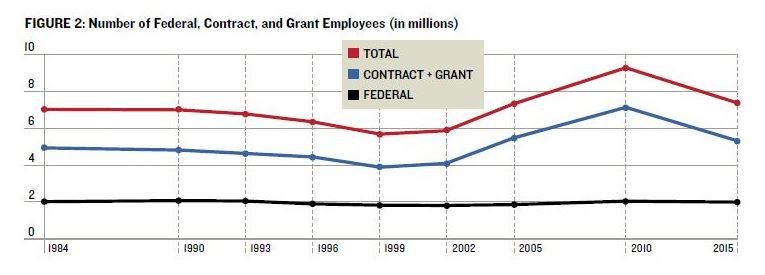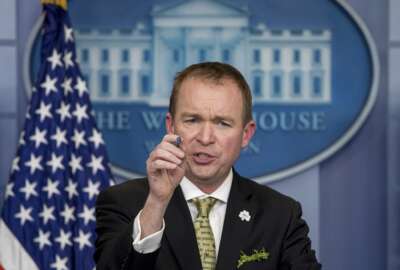
Even a government reorg may not break decades of federal workforce trends
The age-old question is particularly relevant as agencies prepare to reorganize and cut personnel.
Subscribe to Federal Drive’s daily audio interviews on iTunes or PodcastOne
The Trump administration is breathing new life into the age-old question about the size of the federal workforce, as agencies prepare to reorganize, shift resources and cut personnel in the name of efficiency.
The question came up on day one, when President Donald Trump introduced a temporary hiring freeze to “counter the dramatic expansion of the federal workforce in recent years,” as the new administration described it in January.
But according to Paul Light, a public policy professor at New York University, and a special adviser to the chairman of the Volcker Alliance, the number of federal employees has remained more or less the same over the past several decades. Rather, it’s the number of contractors and grant employees supporting government work that’s trended upward over the years.
About 2 million federal employees, 3.7 million contractors, nearly 1.6 million grant employees, 1.3 million active-duty military members and 492,000 postal workers all make up the “blended federal workforce,” Light said in his latest report on the topic.

The size of the federal workforce has risen and fallen slightly over the decades, as administrations prepare for war, scale back, rebuild and then shrink again, Light said.
“We rebuilt that very contract-heavy and grant-heavy government in the 2000s, as we went to war and with the stimulus, and we have been reducing this since,” he said. “We’ll see. There is a pattern here. It’s not steady state. The only relatively steady number in these estimates is the number of federal employees, which hovers around 2 million or less.”

Government also has significantly more managers and layers of leadership today than it did more than 60 years ago. By Light’s estimate, government had 71 layers of 3,265 leaders in 2016, compared to 17 layers of 451 leaders in 1960.
Federal experts agreed agency mission should drive employment numbers, not arbitrary caps on federal employment. The same mission should also determine who fills the positions needed to accomplish the work, Light said.
“I don’t think we want to use the headcount to say it’s efficient or not efficient, because I don’t think we know,” Light said. “The point is to get out of headcount and into a more robust conversation about what all these people do and whether they’re doing it at the most efficient level.”
Rep. Elijah Cummings (D-Md.) wants those conversations to happen in a public forum.
He and other Democrats on the House Oversight and Government Reform Committee are asking Chairman Trey Gowdy (R-S.C.) to hold hearings on agencies’ efforts to cut their workforces. As part of that report, they want copies of the agencies’ reform plans that were due to the Office of Management and Budget on Sept. 30.
The committee should also specifically review the president’s temporary hiring freeze, which some agencies have extended once the administration lifted it in April, Cummings and his Democratic colleagues said.
“Our committee has jurisdiction over both the federal workforce and proposed agency reorganizations, and the Trump administration is now in the midst of one of the largest reorganizations in decades with virtually no oversight by Congress,” they wrote. “As members of this committee, we believe it is our job to analyze the Trump administration’s plans to determine if, and to what extent, these massive reductions in staffing will impact the services the American people rely on every single day.”
In many cases, it’s still unclear exactly how much agencies plan to cut from their employment rolls.
“I’d make a pretty strong guess that the Trump administration is going to try to break through the 2 million mark and get total federal employment down to 1.9 [million], 1.8 million,” Light said.
Buyouts and early retirement offers will be a part of that effort. Agencies like the Environmental Protection Agency and Interior Department have already or are planning to offer Voluntary Early Retirement Authority (VERA) and Voluntary Separation Incentive Payments VSIP) to their employees.
Congress is considering an increase for VSIP payments, and Light ultimately believes it will pass. As a result, he predicted 100,000-to-200,000 employees would leave their agencies.
“If we do that correctly, we’ll create opportunities for a lot of federal employees to move up,” he said. “If we streamline the hiring process and work with basic civil service reforms, we’ll get a better civil service.”
Yet some federal experts doubt that meaningful changes to the civil service can happen.
“It takes both parties deciding that you want to make government work better [and] you want to make it more efficient,” said Norman Ornstein, resident scholar at the American Enterprise Institute. “It takes a broader understanding that the system is broken. It takes a president who really does want to do a reform. … We don’t have any of those elements there now.”
Copyright © 2024 Federal News Network. All rights reserved. This website is not intended for users located within the European Economic Area.
Nicole Ogrysko is a reporter for Federal News Network focusing on the federal workforce and federal pay and benefits.
Follow @nogryskoWFED
Related Stories





